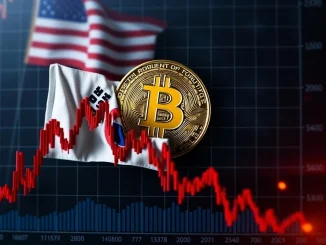
Imagine a world where digital dollars are seamlessly integrated into global commerce, creating new opportunities and potentially strengthening the U.S. financial position. That future could be closer than we think, according to a key figure within the U.S. government. The stablecoin market is currently valued in the tens of billions, but a recent projection from the highest levels of the US Treasury suggests an astonishing potential for expansion.
What Did the US Treasury Secretary Predict for the Stablecoin Market?
In a significant statement shared on X, U.S. Treasury Secretary Scott Bessent offered a compelling vision for the future of digital currencies. He projected that the global stablecoin market could experience explosive growth, potentially reaching a staggering $3.7 trillion valuation by the year 2030. This isn’t just a hopeful forecast; Bessent directly linked this ambitious target to specific legislative action.
He stated that achieving this outcome is significantly more likely with the successful implementation of the GENIUS Act. This proposed legislation aims to establish a clear, federal regulatory framework specifically designed for the issuance and trading of stablecoins that are backed by the U.S. dollar.
How Does the GENIUS Act Fuel Stablecoin Growth?
The passage of the GENIUS Act is seen as a critical catalyst for potential stablecoin growth. By providing a predictable and clear set of rules, the act intends to build confidence and encourage broader adoption among businesses and consumers alike. A robust regulatory framework can mitigate risks, attract institutional participation, and pave the way for stablecoins to be used more widely in payments, remittances, and other financial activities.
The U.S. Senate recently demonstrated bipartisan support for this direction, giving final approval to the GENIUS Act on June 17th. This legislative momentum underscores the growing recognition within Washington of stablecoins’ potential economic importance.
The Digital Dollar Economy: Who Benefits?
Secretary Bessent articulated a clear picture of the widespread benefits that a thriving stablecoin market, enabled by the GENIUS Act, could bring. He described it as a ‘win’ for multiple stakeholders:
- The Private Sector: Businesses could leverage stablecoins for more efficient and cheaper transactions, potentially unlocking new business models in the growing digital dollar economy.
- The U.S. Treasury: A strong stablecoin market, particularly one dominated by dollar-backed stablecoins, would naturally increase private sector demand for U.S. Treasuries, as these assets are often used as reserves.
- Consumers: Millions of new users could be brought into the digital economy, gaining access to faster, lower-cost financial services facilitated by stablecoins.
This increased demand for Treasuries, driven by stablecoin reserves, could have significant positive ripple effects for the government. It could help lower borrowing costs, making it cheaper for the U.S. government to finance its operations. Over time, this could contribute to easing the national debt burden – a key objective for the US Treasury.
Looking Ahead: The Future of the Stablecoin Market
The vision outlined by the US Treasury Secretary paints a compelling picture of a future where stablecoins play a central role in the global financial landscape, deeply intertwined with the strength and reach of the U.S. dollar. The potential for the stablecoin market to swell to $3.7 trillion within just five years highlights the immense opportunity seen by policymakers.
This potential is closely tied to the success of legislative efforts like the GENIUS Act in creating a stable and reliable environment for this technology to flourish. As the framework develops and adoption grows, the benefits outlined – from easing national debt to expanding the digital dollar economy – could become tangible realities, making this a space well worth watching.



